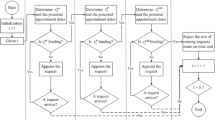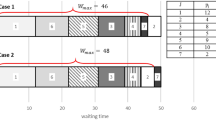Abstract
This paper investigates appointment scheduling for an outpatient department in West China Hospital (WCH), one of the largest single point of access hospitals in the world. Our pilot data analysis shows that the appointment system at WCH can be improved through leveraging the scheduling window (i.e., the number of days in advance a patient makes an appointment for future services). To gain full insight into this strategy, our study considers two cases, based on if patients are willing to wait for scheduled appointments or not. We developed a stylized single server queueing model to find optimal scheduling windows. Results show that, when patients are less sensitive to time delay (i.e., patients will wait for scheduled services), levering scheduling windows is not effective to minimize the total cost per day of the appointment system. In contrast, when patients are sensitive to time delay (i.e., patients may find services elsewhere), then our model considers the potential cost of physician idle time. The modeling results indicate that the total cost per day is relatively sensitive to the magnitude of scheduling window. Thus, adopting a proper scheduling window is very important. In addition, our study proves that the cost functions of both cases are quasi-concave, which are also validated by actual data drawn from the Healthcare Information System at WCH. A comparison of numerical results between two cases is made to draw further managerial insights into scheduling policies for WCH. Discussion of our findings and research limitations are also provided.









Similar content being viewed by others
References
Garza A (2016) The aging population: The increasing effects on health care. Pharm Times. http://www.pharmacytimes.com/publications/issue/2016/january2016/the-aging-population-the-increasing-effects-on-health-care. Accessed 31 July 2016
Chang J, Wood D, Jia X, Gifford B (2008) Emerging trends in Chinese healthcare: the impact of a rising middle class. J Int Hospital Federation 44(4):11–20
Eggleston K (2012) Health care for 1.3 billion: An overview of China’s health system. Asia Health Policy Program, working paper series on health and demographic change in the Asia-Pacific, paper # 28, Stanford University
Brandenburg L, Gabow P, Steele G, Toussaint J, Tyson BJ (2015) Innovation and best practices in health care scheduling. IOM, NAM Web. https://nam.edu/perspectives-2015-innovation-and-best-practices-in-health-carescheduling/. Accessed 25 Aug 2016
World Health Organization (2015) WHO global strategy on people-centered and integrated health services. http://www.who.int/servicedeliverysafety/areas/people-centred-care/global-strategy/en/. Accessed 25 Aug 2016
Gupta D, Denton B (2008) Appointment scheduling in health care: challenges and opportunities. IIE Trans 40(9):800–819
Gallucci G, Swartz W, Hackerman F (2005) Impact of the wait for an initial appointment on the rate of kept appointments at a mental health center. Psychiatr Serv 56(3):344–346
Liu N, Ziya S (2014) Panel size and overbooking decisions for appointment-based services under patient no-shows. Prod Oper Manag 23(12):2209–2223
He AJ, Qian J (2016) Explaining medical disputes in Chinese public hospitals: the doctor–patient relationship and its implications for health policy reforms. Health Econ Policy Law 11(4):359–378
Sinsky CA, Willard-Grace R, Schutzbank AM, Sinsky TA, Margolius D, Bodenheimer T (2013) In search of joy in practice: a report of 23 high-functioning primary care practices. Ann Fam Med 11(3):272–278
Liu N (2016) Optimal choice for appointment scheduling window under patient no-show behavior. Prod Oper Manag 25(1):128–142
Bailey NTJ (1952) A study of queues and appointment systems in hospital out-patient departments, with special reference to waiting-times. J R Stat Soc Ser B Methodol 14(2):185–199
Cayirli T, Veral E (2003) Outpatient scheduling in health care: a review of literature. Prod Oper Manag 12(4):519–549
Kaandorp GC, Koole G (2007) Optimal outpatient appointment scheduling. Health Care Manag Sci 10(3):217–229
Lindley DV (1952) The theory of queues with a single server. Math Proc Camb Philos Soc 48(2):277–289
Ahmadi-Javid A, Jalali Z, Klassen KJ (2017) Outpatient appointment systems in healthcare: a review of optimization studies. Eur J Oper Res 258(1):3–34
Denton B, Gupta D (2003) A sequential bounding approach for optimal appointment scheduling. IIE Trans 35(11):1003–1016
Feldman J, Liu N, Topaloglu H, Ziya S (2014) Appointment scheduling under patient preference and no-show behavior. Oper Res 62(4):794–811
Gocgun Y, Puterman ML (2014) Dynamic scheduling with due dates and time windows: an application to chemotherapy patient appointment booking. Health Care Management Science 17(1):60–76
Klassen KJ, Rohleder TR (1996) Scheduling outpatient appointments in a dynamic environment. J Oper Manag 14(2):83–101
Nguyen TBT, Sivakumar AI, Graves SC (2016) Scheduling rules to achieve lead-time targets in outpatient appointment systems. Health Care Manag Sci. https://doi.org/10.1007/s10729-016-9374-2
Patrick J (2012) A Markov decision model for determining optimal outpatient scheduling. Health Care Management Science 15(2):91–102
Cayirli T, Yang KK, Quek SA (2012) A universal appointment rule in the presence of no-shows and walk-ins. Prod Oper Manag 21(4):682–697
Green LV, Savin S (2008) Reducing delays for medical appointments: A queueing approach. Oper Res 56(6):1526–1538
Hassin R, Mendel S (2008) Scheduling arrivals to queues: a single-server model with no-shows. Manag Sci 54(3):565–572
Klassen KJ, Yoogalingam R (2009) Improving performance in outpatient appointment services with a simulation optimization approach. Prod Oper Manag 18(4):447–458
Liu N, Ziya S, Kulkarni VG (2010) Dynamic scheduling of outpatient appointments under patient no-shows and cancellations. Manuf Serv Oper Manag 12(2):347–364
Robinson LW, Chen RR (2010) A comparison of traditional and open-access policies for appointment scheduling. Manuf Serv Ope Manag 12(2):330–346
Begen M, Queyranne M (2011) Appointment scheduling with discrete random durations. Math Oper Res 36(2):240–257
Chakraborty S, Muthuraman K, Lawley M (2010) Sequential clinical scheduling with patient no-shows and general service time distributions. IIE Trans 42(5):354–366
Kim S, Giachetti RE (2006) A stochastic mathematical appointment overbooking model for healthcare providers to improve profits. IEEE Trans Syst Man Cybern Part A Syst Hum 36(6):1211–1219
LaGanga LR, Lawrence SR (2007) Clinic overbooking to improve patient access and increase provider productivity. Decis Sci 38(2):251–276
Muthuraman K, Lawley M (2008) A stochastic overbooking model for outpatient clinical scheduling with no-shows. IIE Trans 40(9):820–837
Zacharias C, Pinedo M (2014) Appointment scheduling with no-shows and overbooking. Prod Oper Manag 23(5):788–801
Zeng B, Turkcan A, Lin J, Lawley M (2010) Clinic scheduling models with overbooking for patients with heterogeneous no-show probabilities. Ann Oper Res 178(1):121–144
Norris JB, Kumar C, Chand S, Moskowitz H, Shade SA, Willis DR (2014) An empirical investigation into factors affecting patient cancellations and no-shows at outpatient clinics. Decis Supp Sci 57:428–443
Acknowledgements
This project was sponsored by the Nature Science Foundation of China (71532007, 71131006, 71172197 and 70771068), Central University Fund of Sichuan University Number skgt201202 and Science and Technology Department Project of Sichuan Province (2015ZR0097). The authors gratefully acknowledged the support from the department of operations management in West China Hospital.
Author information
Authors and Affiliations
Corresponding author
Ethics declarations
Conflict of interest
None
Appendix A: Proofs of the Proposition
Appendix A: Proofs of the Proposition
Lemma 1[18]. For a, c, b, d ≥ 0, if \( \frac{c}{d}\le \left(<\right)\frac{c}{d}, \) then
Proof of Proposition 1:
First, we prove S1 is nonempty. ∀ρ, 1 ∈ S1. Since \( T(0)=\theta \lambda, T(1)=\frac{\theta \lambda \rho}{1+\rho } \)
For N ≥ 2, N ∈ S1,
According to Lemma 1,
i.e. ∀N ∈ S, T(N) ≤ T(N − 1).
Consider sup S < ∞ , let \( {N}_1^{\ast }={supS}_1, \) we need to prove T(N) is increasing in N, i.e. \( T\left({N}_1^{\ast }+1\right)>T\left({N}_1^{\ast}\right) \).
Let’s set
Apparently,
According to Lemma 1, Eqs. (15) and (16)
Then, we could obtain that T(N) is increasing in N.
In summary, T(N) is decreasing as N increases to \( {N}_1^{\ast } \), and then strictly increasing. The objective function T(N) is quasi-concave in N.
Proof of Proposition 2:
Same as Proposition 1, T′(1) < T′(0)
For N ≥ 2, N ∈ S2
According to Lemma 1 and function (18)
Also, consider sup S2 < ∞ , let \( {N}_2^{\ast }={supS}_2, \)we need to prove \( {T}^{\prime}\left({N}_2^{\ast }+1\right)>{T}^{\prime}\left({N}_2^{\ast}\right) \).
Let’s set
and \( {g}^{\prime}\left({N}_2^{\ast }+1\right)=\xi {N}_2^{\ast }+\theta \lambda +\omega \lambda -\frac{\theta \lambda}{\rho_{N_2^{\ast }+1}^{\prime }}>{g}^{\prime}\left({N}_2^{\ast}\right) \)
In summary, T′(N) is decreasing asNincreases to \( {N}_2^{\ast } \), and then strictly increasing. The objective function T′(N)is quasi-concave in N.
Rights and permissions
About this article
Cite this article
Luo, L., Zhou, Y., Han, B.T. et al. An optimization model to determine appointment scheduling window for an outpatient clinic with patient no-shows. Health Care Manag Sci 22, 68–84 (2019). https://doi.org/10.1007/s10729-017-9421-7
Received:
Accepted:
Published:
Issue Date:
DOI: https://doi.org/10.1007/s10729-017-9421-7




